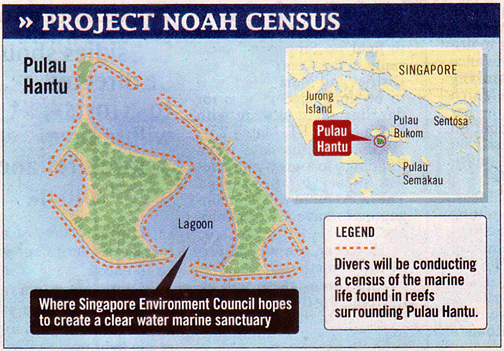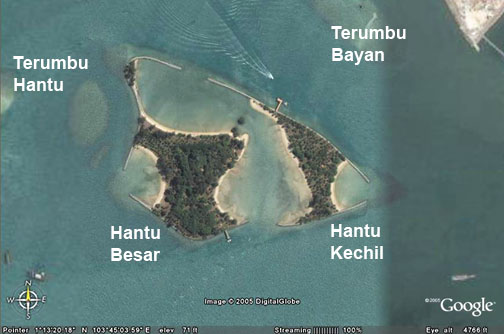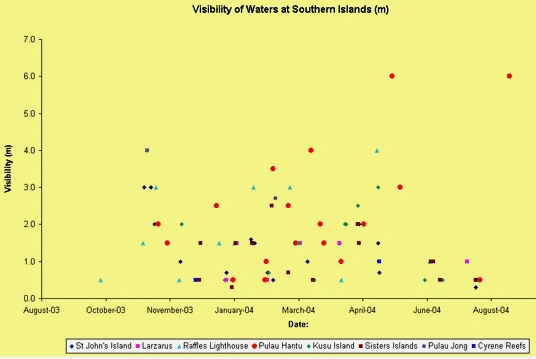| Plans
to 'build a reef' at Hantu: some issues updated 3 Jun 06 "Singapore Underwater Federation ... aims to build a coral reef in the lagoon enclosed by Pulau Hantu" media reports Their publicised plans include the following, which raises some questions... Census of Hantu and our reefs SUF will "conduct the largest census of marine biodiversity undertaken here" ST 31 Mar 06 How will the SUF census be different from the surveys of all our reefs that are already ongoing and for which data is already available online? more How will this reef be 'built'? "They are also planning to move corals from other reefs to the island." CNA 30 Mar 06 Past coral relocation efforts in Singapore: have they worked? more Where are these 'other' reefs from which corals will be taken? "Plans are under way to create a simple sand filtration system to eliminate most of the sediment from the water flowing into the lagoon, creating a clear water habitat." ST 31 Mar 06 Does this mean the 'built reef' will be isolated from the surroundings? (in effect, a giant aquarium). Filter-speak: What does filtration involve? What are the risks to the habitat? Where will this reef be located on Pulau Hantu? Location of 'built reef' is as indicated below... 
Pulau Hantu is made up of two smaller islands: Hantu Besar and Hantu Kecil. The map provided in the media (above) suggests there these two islands are well separated and that there are corals around each of the smaller islands. In reality, there is a shallow lagoon between the two islands. At low tide, this lagoon is exposed out of water. At high tide, the water reaches about 1.5-2m in height on average. This allows comfortable and safe swimming. While snorkelling is possible, diving is not practical in the lagoon as it currently is. 
Coral reefs have regenerated outside the man-made seawalls. There are several submerged reefs near Pulau Hantu. These are called 'terumbus'.This lagoon and the reef flats are already teeming with marine life. What is the state of marine life on Pulau Hantu today? Webpages with photos of what you can see at Pulau Hantu right now. To 'build' the reef in this lagoon will probably involve extensive changes to the depth of the lagoon. What will impact be on existing marine life there and in the surrounding reef flats and terumbus? Other issues... "The divers, however, face a difficult task because of poor visibility caused by silt suspended in the water. It can be so bad that 'you have to bump into coral to notice them', said Project Noah manager Spencer Lewis." ST 31 Mar 06 Will SUF divers involved in the census be properly trained so as not to damage our reefs as they do their census? See also Cashing in on Corals about studies on the damage caused to reefs by divers who touch corals. (The visibility in our waters is not always that bad. In fact, the vis at Hantu can be quite good and may be among the best of our Southern islands, see chart below and discussion of viz on the habitatnews blog thanks to Siva for the alert. Professionals, scientists and regular divers in our waters generally know how to manage underwater activities without damaging our reefs. They would certainly not 'bump' into corals to find them). 
"Mr Chew emphasised that 'the lagoon isn't just for divers', saying: 'It's for anyone who wants to get wet and enjoy our marine life.'" ST 31 Mar 06 How will the created reef be managed? In particular, will the impact on the reef and surrounding habitats be well managed? "Mr Lewis sees the likelihood of Project Noah developing into a lucrative business" BT 31 Mar 06 What will the environmental impact be if the 'built reef' is run as a commercial enterprise? Cashing in on corals: impact of divers and boaters on reefs some extracts of studies done on the issue. Who are the project leads? What are their interests in the project? More about why this is vague in the reports of the SUF briefing. In the press release (PDF file), Sydney Chew was identified as Managing Director of Aquos Pte Ltd and SUF member. Here is the ACRA printout (PDF file) about the company. What are the issues in evaluating a proposal to reef rehabilitation? See this PDF document on the Reef Check website "Beware Hype on Artificial Reef Rehabilitiation" a document of the International Coral Reef Initiative which in summary states, among others, that "The most effective mechanism of rehabilitating coral reefs is through mitigation of chronic human disturbances (e.g. sedimentation, pollution and over-fishing), thereby facilitating natural recovery mechanisms and building resilience, to any further disturbances, that will be effective over large areas"; "In addition to effectiveness considerations, construction of any engineered structure on a coral reef must be evaluated against any potential environmental damage caused during construction or later degradation" "Some innovative and new approaches to coral reef conservation and management may have limited applications, there have been insufficient peer-reviewed, long-term scientific studies of reef rehabilitation using these techniques and few cost-benefit analyses to assess effectiveness of the methods over natural recovery processes." "Governments, international agencies, NGOs and other parties [are advised] that they should carefully examine claims from commercial and non-commercial groups selling or proposing ‘engineering’ solutions for coral reef rehabilitation and to seek advice recognised scientific bodies before investing in risky, unproven and expensive engineering techniques which may exacerbate environmental damage and divert funds away from more effective measures" |
| You
CAN make a difference LEARN about the issues Get updates on this and other nature issues in Singapore Sign up for the free daily wildsingapore newsletter Past newsletter with major postings on the issue NOAH sunk 26 May 06 Hantu project: did the press get it wrong?; Can reefs exist in murky waters? 19 Apr 06 Hantu is ALIVE! and other updates 15 Apr 06 Hantu updates 14 Apr 06 'Built reef' at Hantu plan: updates on SUF briefing 13 Apr 06 SUF to present on project NOAH at NSS Conservation Chat 12 Apr (Wed) 10 Apr 06 Hantu updates: what are the issues? what marine life is already at Hantu? 10 Apr 06 Hantu 'built reef' plan: more questions and thoughts 7 Apr 06 The Hantu plan: a lucrative business?; what do divers think of the plan? 5 Apr 06 Building a reef in Pulau Hantu's lagoon: your views sought 3 Apr 06 'Building' a reef at Pulau Hantu; another Hantu census? 31 Mar 06 Media reports 'Marine sanctuary' plan for Pulau Hantu dropped by Radha Basu The Straits Times 3 Jun 06 PDF of press release (it was also circulated at the SUF briefing) on the Hantu blog and on wildsingapore First step to create marine sanctuary on Pulau Hantu by Tania Tan The Straits Times 31 Mar 06 New Singapore diving hotspot in the pipeline By Sim Ping Khuan Singapore Business Times 31 Mar 06 Preserving undersea treasures Cheow Xin Yi Today Online 31 Mar 06 Singapore Underwater Federation to build coral reef at Pulau Hantu By Sharon See, Channel NewsAsia Channel NewsAsia 30 Mar 06 Briefing by SUF on the plan at NSS Conservation Chat 12 Apr 06 (Wed) Full minutes of meeting on the BWV website Details of inconsistencies on Debby's Hantu Blog Project NOAH discussed at an open session at the Nature Society (SIngapore) on Siva's habitatnews No Ah-dea at all a personal view of the briefing by a young enviromental newbie NO-'AH-dea': Ignorance is NOT bliss another personal view of the briefing by a young environmentalist, Jani on her Salted Fried Tempeh blog Have You Have Any Ah-dea? on the Colorful Clouds blog The Far Side of Fritos a light-hearted account of the SUF briefing by Joseph Lai on his eart-h.com Second dialogue session on 25 May 06 (Thu) Update: Project NOAH sunk on Debby's Hantu Blog Project NOAH no more on Siva's Habitatnews Blog Draft agenda for the follow-up dialogue session NOAH  SPEAK
UP for Pulau Hantu SPEAK
UP for Pulau HantuOnline discussions of the plan nature-singapore list clubsnap forum finsonline forum the Reefwalk blog CNA forum Blog entries about the plan More about Project Noah on the Dogged Nature blog Diving in Singapore: a tribute part II contrary to SUF's claim that there are only 2 dive sites open in Singapore, there are 15 such spots! Jani regales with tales and photos on her Blue Tempeh blog Lagoon Blues: A reef in double jeopardy a look at the issues in the inimitable style of the Annotated Budak blog with comments contributed about viability of relocation and competition among corals. Special Feature: Pulau Hantu photos of Hantu shared by a volunteer guide at both Chek Jawa and Semakau who hails from a Pengerang Sea Shore Thoughts about Hantu after reading Debby's blog about the reclamation at Terumbu Bayan by Dolphy with comments about the plan to 'build a reef' at Hantu. Surveying a Sanctuary the water may not be clear but there are clearly LOTS of corals and marine life for those that will see. Fab photos on the Hantu blog Noah's Ark on the Fire and Light blog More links Have surveys been done of Pulau Hantu and our reefs? Reef Check ongoing bimonthly surveys of all major reefs in Singapore by the Blue Water Volunteers ReefFriends programme involving volunteers using a combination of Reef Check and AIMS Line Intercept Transect methods. All data is posted on the web. Here is data on Hantu The Reef Survey and Conservation Project: by the Republic of Singapore Yacht Club (RSYC), Singapore Institute of Biology (SIBiol) and Singapore Underwater Federation (SUF) from 1987-1991. More details on the Coral Reefs of Singapore website Have coral relocations been done in the past? The Reef Rescue Project by the Marine Conservation Group of the Nature Society of Singapore 1991 and 1995. More details on the Coral Reefs of Singapore website Does reef relocation work? See Adopt a reef, and save the coral By Chang Ai-Lien Science Correspondent The Straits Times, 28 Jun 05 And discussion of this proposal on nature-singapore discussion list Jani's The Blue Tempeh blog compiled on Siva's habitatnews blog More about Pulau Hantu Hantu Bloggers Pulau Hantu on wildsingapore Pulau Hantu on Coral Reefs of Singapore with links to photos and reef survey results Hauntingly Beautiful Hantu n the WildFilms blog More about the state of our reefs Jani's A tribute to Singapore's coral reefs. PART 1 The Blue Tempeh blog Danwei's A tribute to Singapore's coral reefs. PART 1 (An Appendix) on the Reefwalk blog |
|
|
